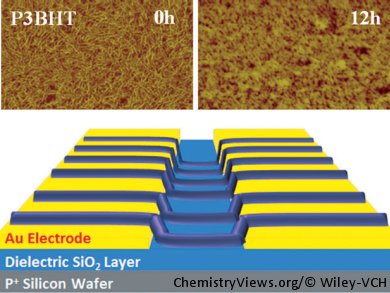Researchers in the USA and China have reported a new route for the fabrication of hierarchical assemblies of conjugated polymers. Zhiqun Lin and his co-workers at the Georgia Institute of Technology, USA, Fudan University, China, and the University of Massachusetts, USA, confined a drying droplet containing the conjugated polymers poly(3-hexylthiophene (P3HT), poly(3-butylthiophene (P3BT), and poly(3-butylthiophene)-b-poly(3-hexylthiophene) (P3BHT) to the geometry created by a cylindrical lens on a flat silicon substrate.
The different interfacial interactions between the polymers and the substrate result in the formation of highly ordered straight or wavy stripes. These comprise either nodule-like nanodomains or nanofiber-like morphologies, depending on the choice of polymer.
The team showed that solvent vapor annealing resulted in a morphological rearrangement from nanofibers to nodule-like aggregates. The increase in crystallinity after annealing resulted in a fourfold increase in electrical conductivity of the assemblies.
The authors speculate that this strategy has great potential in the fabrication of highly structured materials.
- Large-Scale Hierarchically Structured Conjugated Polymer Assemblies with Enhanced Electrical Conductivity,
Wei Han, Ming He, Myunghwan Byun, Bo Li, Zhiqun Lin,
Angew. Chem. Int. Ed. 2013.
DOI: 10.1002/anie.201209632




